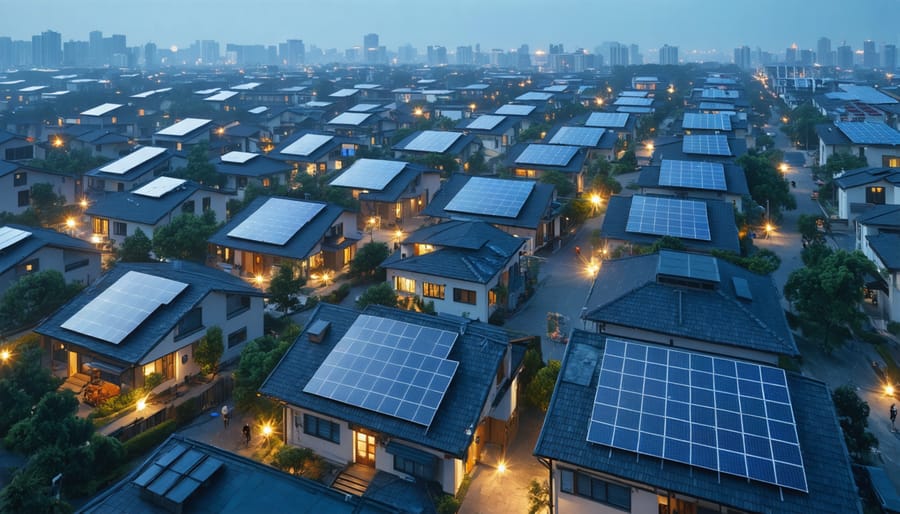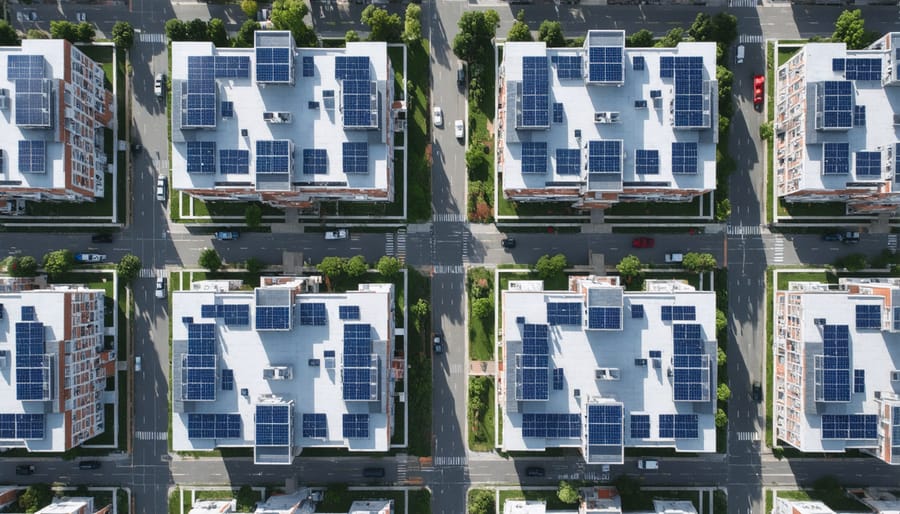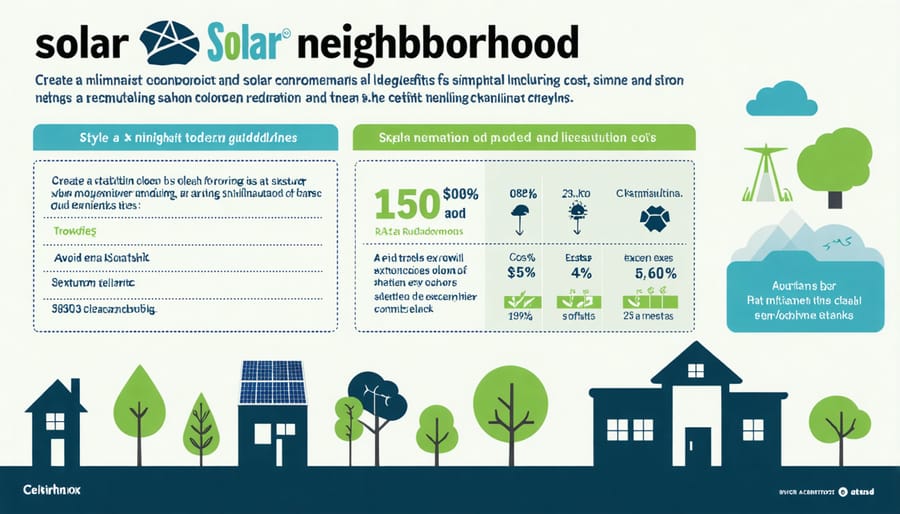Solar Neighborhoods Transform Urban Living: How Dense Cities Are Going Green

Transform entire neighborhoods into sustainable energy hubs by unlocking the full solar potential in urban areas through systematic community-wide implementation. Solar neighborhoods represent the next evolution in sustainable urban development, combining smart grid technology, shared energy storage systems, and integrated solar infrastructure across multiple properties.
Modern European cities are witnessing a remarkable shift as entire districts transition to solar-powered communities, reducing energy costs by 40-60% while strengthening grid resilience. These innovative developments integrate rooftop solar arrays, energy-sharing platforms, and smart management systems that optimize power distribution across hundreds of interconnected homes.
The concept extends beyond individual solar installations to encompass comprehensive urban planning solutions – from solar-ready building codes to community-owned microgrids. By implementing district-wide solar initiatives, neighborhoods create resilient energy ecosystems that maximize efficiency through shared resources and synchronized consumption patterns.
Success stories from cities like Amsterdam and Copenhagen demonstrate how solar neighborhoods drive property values up while pushing energy costs down, creating a compelling model for sustainable urban development across Europe.
Reimagining Urban Energy: The Solar Neighborhood Concept

Smart Grid Integration
Solar neighborhoods represent a significant advancement in distributed energy systems, connecting individual solar installations into a cohesive network that maximizes efficiency and reliability. Through sophisticated smart grid technologies, these communities can intelligently manage power flow, balance supply and demand, and optimize energy distribution across multiple households.
The integration process involves installing advanced meters, sensors, and communication systems that enable real-time monitoring and automated load balancing. When one home produces excess solar energy, the system automatically redirects it to neighbors with higher demand, reducing waste and maximizing local energy consumption. This networked approach also enhances grid stability by incorporating energy storage solutions and intelligent power management systems.
European neighborhoods implementing these systems have demonstrated remarkable improvements in energy efficiency, with some communities achieving up to 60% greater utilization of their solar resources compared to standalone installations. The smart grid infrastructure also enables dynamic pricing models, allowing residents to optimize their energy consumption patterns and reduce costs while contributing to a more sustainable urban energy ecosystem.
Shared Solar Infrastructure
Shared solar infrastructure represents a cornerstone of modern solar neighborhoods, offering an innovative approach to renewable energy adoption in urban settings. These communal installations typically consist of centralized solar arrays installed on suitable community spaces, such as parking structures, community centers, or dedicated solar fields within the neighborhood.
The system works by distributing solar-generated electricity among multiple households through a smart grid network, enabling residents to benefit from solar power without installing individual rooftop systems. This arrangement proves particularly valuable in areas with heritage buildings, shared rooftops, or properties with suboptimal solar exposure.
The benefits of shared solar infrastructure are substantial. Communities can achieve economies of scale, reducing installation and maintenance costs per household. Professional management ensures optimal system performance, while smart metering technology allows for fair distribution of energy credits among participants. This approach also maximizes space efficiency in dense urban environments, making solar power accessible to a broader range of residents.
For European cities pursuing sustainability goals, shared solar installations offer a practical solution that combines energy efficiency with urban planning considerations, fostering community engagement in renewable energy initiatives.
Innovative Design Solutions for Dense Urban Areas
Vertical Solar Integration
Vertical solar integration represents a significant advancement in urban solar deployment, maximizing energy generation potential in densely populated areas. Modern innovative solar integration solutions now enable buildings to harness solar power not just from rooftops, but also from their vertical surfaces.
Building-integrated photovoltaic (BIPV) systems can be seamlessly incorporated into facades, windows, and balconies, transforming ordinary architectural elements into power-generating assets. These installations typically utilize specialized solar panels designed for vertical mounting, featuring enhanced aesthetics and optimized performance at non-traditional angles.
Recent technological developments have introduced semi-transparent solar panels that can replace traditional windows while generating electricity. These solutions are particularly valuable in high-rise buildings where roof space is limited relative to the vertical surface area available.
Vertical installations often benefit from different sun angles throughout the day, potentially capturing morning and afternoon sun more effectively than conventional roof installations. This can help smooth out daily power generation curves and reduce peak load demands on the grid.
When planning vertical solar integration, considerations must include facade orientation, shading patterns from neighboring structures, and local building regulations. Modern mounting systems are designed to maintain building integrity while ensuring optimal panel performance and easy maintenance access.

Space-Efficient Storage Solutions
In urban environments where space comes at a premium, innovative storage solutions are revolutionizing how solar neighborhoods manage their energy reserves. Modern battery systems have evolved significantly, offering compact designs that can be seamlessly integrated into existing infrastructure without compromising valuable living space.
Vertical storage installations are gaining popularity across European cities, utilizing wall-mounted systems that transform previously unused spaces into functional energy storage areas. These solutions can be installed in underground parking facilities, technical rooms, or even integrated into architectural elements of buildings, preserving precious ground space for community use.
Smart modular storage systems allow for scalable solutions that can grow with community needs. These systems can be distributed across multiple locations within a neighborhood, reducing the need for large centralized storage facilities while improving system resilience. Some innovative developments include storage units integrated into street furniture or beneath solar carports, maximizing space efficiency while maintaining urban aesthetics.
Recent technological advances have also led to the development of high-density batteries that pack more storage capacity into smaller volumes. These advanced systems can store up to three times more energy than traditional solutions while occupying the same footprint, making them ideal for dense urban environments.
For multi-story buildings, basement-level storage solutions are becoming increasingly sophisticated, incorporating climate control systems and smart monitoring capabilities while remaining practically invisible to residents.

Community Benefits and Economic Impact
Reduced Energy Costs
Solar neighborhoods demonstrate significant financial advantages through reduced energy costs, benefiting both residents and businesses. Homeowners typically see a 50-70% reduction in their annual electricity bills, with some achieving near-zero energy costs during peak summer months. This substantial saving potential becomes even more impactful when implemented across entire communities.
For businesses operating within solar neighborhoods, the economic benefits are equally compelling. Commercial properties can reduce their operational costs by 40-60% through shared solar infrastructure and smart grid integration. These savings are particularly notable in energy-intensive sectors such as retail and office spaces.
The collective purchasing power of solar neighborhoods also leads to reduced installation and maintenance costs. Community-wide solar initiatives often qualify for enhanced government incentives and preferential financing options, making the initial investment more accessible. Additionally, many European countries offer feed-in tariffs and tax benefits specifically designed for community solar projects.
Long-term financial planning becomes more predictable with solar energy, as communities are less vulnerable to conventional energy price fluctuations. This stability particularly appeals to businesses, allowing for more accurate operational cost forecasting and improved budget management. The return on investment typically manifests within 5-8 years, while the systems continue generating savings for 25+ years.
Environmental Impact
Solar neighborhoods demonstrate remarkable environmental benefits through measurable carbon reduction achievements. Recent studies across European solar communities show that a typical solar neighborhood of 100 homes reduces carbon emissions by approximately 450-600 tonnes annually, equivalent to removing 100 cars from the road.
These developments contribute significantly to urban sustainability goals. In addition to carbon reduction, solar neighborhoods help decrease local air pollution and reduce urban heat island effects through smart design integration. The implementation of shared solar systems typically results in a 60-70% reduction in grid electricity consumption, with some communities achieving near carbon neutrality during peak summer months.
Environmental monitoring data from established solar neighborhoods in Germany and the Netherlands reveals that these communities reduce water consumption by 30% through integrated water management systems. Additionally, the incorporation of green spaces and solar-powered infrastructure has led to documented increases in local biodiversity, with some projects reporting up to 40% more bird and insect species compared to traditional developments.
The cumulative impact extends beyond immediate environmental benefits, as solar neighborhoods often inspire surrounding communities to adopt sustainable practices, creating a ripple effect of positive environmental change throughout urban areas.
Implementation Strategies and Support
Successful implementation of solar neighborhoods requires a well-structured approach combining technical expertise, community engagement, and strategic planning. Local authorities and developers can leverage existing frameworks and resources while partnering with experienced solar consultants to ensure optimal results.
The first crucial step involves conducting comprehensive site assessments to determine solar potential and infrastructure requirements. This includes analyzing roof orientations, shading patterns, and existing electrical systems. Modern planning tools and software can help optimize panel placement and predict energy yields with remarkable accuracy.
Financial planning is equally important, with various funding mechanisms available across Europe. Communities can explore options such as collective purchasing schemes, solar cooperatives, and green energy grants. Many regions offer specialized funding programs supporting the evolution of solar technology and its implementation in residential areas.
Professional support networks play a vital role in successful deployment. This includes certified installers, energy consultants, and legal experts familiar with local regulations. Many municipalities now offer dedicated support offices to guide communities through the planning and implementation process.
To ensure long-term success, establish clear maintenance protocols and monitoring systems. Smart energy management solutions can help optimize consumption patterns and storage capabilities. Regular performance assessments and community feedback sessions help maintain system efficiency and user satisfaction.
Implementation should be phased strategically, often starting with pilot projects in smaller sections before expanding. This approach allows for learning and adaptation while building community confidence and support. Educational programs and demonstration sites can help residents understand and embrace the technology, leading to higher adoption rates and better overall outcomes.
Solar neighborhoods represent a pivotal step towards achieving sustainable urban development across Europe. By combining innovative solar technology with smart urban planning, these communities demonstrate how collective action can transform our cities into energy-efficient, environmentally conscious spaces. The success stories from existing solar neighborhoods in countries like Germany, Denmark, and the Netherlands prove that this concept is not just viable but economically beneficial for residents and municipalities alike.
As we face increasing pressure to reduce carbon emissions and enhance energy independence, solar neighborhoods offer a practical, scalable solution. The integration of shared solar infrastructure, energy storage systems, and smart grid technologies creates resilient communities while significantly reducing energy costs for residents.
The time to act is now. Urban planners, property developers, and community leaders across Europe have the opportunity to pioneer this transformation. By embracing solar neighborhood initiatives, securing available funding, and engaging community support, we can create a network of sustainable urban spaces that benefit both current and future generations. The technology is ready, the economic benefits are clear, and the environmental impact is significant – all that’s needed is the commitment to make it happen.
Leave a Reply